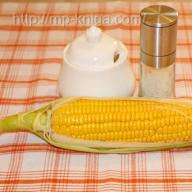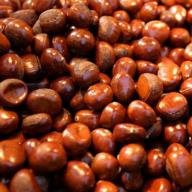Each of us has our own image of perfectly cooked meat: some like baked chicken, some like fried pork kebab, and some like Burgundy beef, which has been stewed for a long time in a fragrant sauce. But no matter what kind of meat you like, you probably want it to be soft and juicy. Really, who would like to chew a hard, dry sole for a long time! But how to cook meat soft and juicy? Is there some secret here?
In fact, there is no secret, there are several rules, and if you follow them, your meat will always turn out soft.
Choose the right meat
The easiest way to cook meat soft and juicy is to take a cut that is soft enough in itself. We know that meat is muscle, but not all muscles work the same. Some are in constant motion, others, such as tenderloin, practically do not work, have a different muscle tissue structure and are softer.
This doesn't mean that tenderloin can be cooked tender while brisket cannot: it's just that the latter contains a large amount of collagen protein, which must be cooked slowly and for a long time. So the most important thing is to choose the right cooking method for the cut you have. Meat that is suitable for barbecue or steak should not be stewed, and vice versa.
Take your time
The most expensive types of meat are ready when you decide that they are ready: for example, steaks are fried not so much to soften the meat, but to obtain a golden crust and achieve the degree of frying at which it will be most tasty. But with less expensive cuts rich in connective tissue, things are different: the collagen contained in it requires a long heat treatment, as a result of which it is converted into gelatin. Gelatin makes the juices contained in meat thicker; they are retained inside the piece even when the structure of the protein changes, and we owe the famous effect of meat melting in the mouth to gelatin.
Was the stew not tender enough? The answer is obvious - you just didn't simmer it long enough. Don’t rush, don’t worry about the fact that when cooking meat for a long time, all the vitamins will “leave” from it, but just give the meat the few hours it needs, and it will thank you in full.
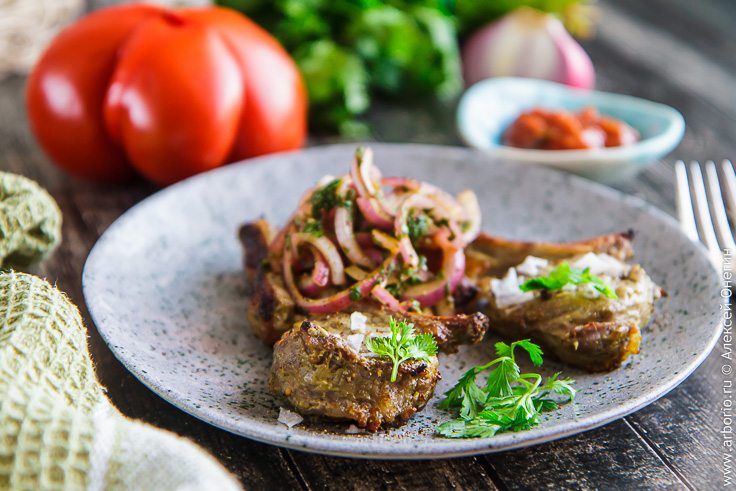
Use acid
Exposure to an acidic environment helps tenderize meat because it denatures the protein. Imagine that a protein consists of many helices interlocking with each other. Under the influence of acid, these spirals straighten, the structure of the meat becomes less rigid - this process is called denaturation. For this reason, before preparing some dishes, such as barbecue, meat is marinated with the addition of acidic foods.
But here, as in everything else, moderation is important: vinegar, pomegranate juice or kiwi pulp, of course, will soften the meat, but will deprive it of taste and texture. The acid found in fermented milk products, wine, onions and similar not very acidic foods is quite enough, and if they are not able to make your meat tender, then you simply chose the wrong piece.
Don't overcook
If you used the right cut of meat and it still came out dry and tough, you may have simply cooked it too long. Regardless of how you prepare meat - boil, stew, bake or fry - the processes that occur inside are almost identical. Under the influence of high temperature, the protein begins to shrink, squeezing out the juices contained in the meat. It will not be possible to completely avoid the loss of juices, but if you stop cooking the meat in time, there will be enough of them to keep the meat juicy.
Some housewives overcook meat out of ignorance, others out of fear that it will remain raw, but this problem can be solved with the help of a simple tool: a kitchen thermometer. Measure the internal temperature of the meat and do not cook it longer than necessary to achieve the desired level of doneness for the cut you choose.
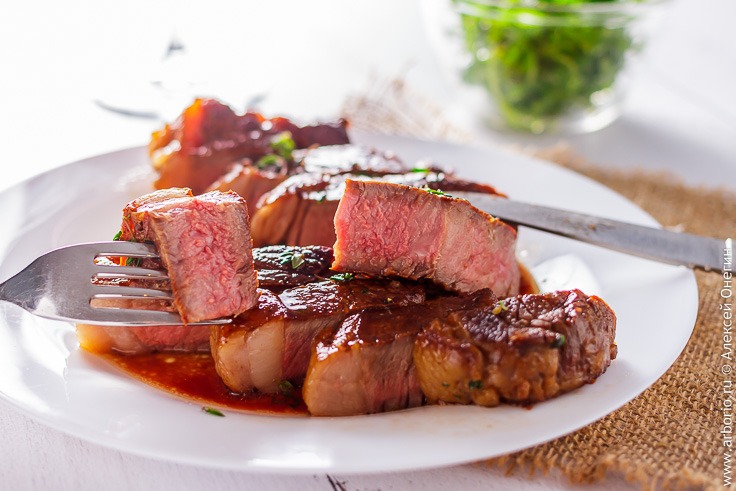
Don't forget about
When exposed to salt, proteins are denatured in the same way as when exposed to acid. The only question here is time, but the marinating process is not quick, and usually takes at least an hour. Pre-salting meat in brine or using a dry method makes it softer, as well as more tasty and juicy, since proteins that have gone through such a “soft” denaturation do not shrink so much during heat treatment, and more juices are retained inside.
Brine is good because it allows you to salt the meat evenly throughout the entire volume so that it takes exactly as much salt as necessary. But if you prefer dry pickling, go ahead. The main thing is not to start frying or baking the meat immediately after you have rubbed it with salt, but let it sit for at least forty minutes.
Defrost slowly
Of course, fresh meat is preferable to frozen, but sometimes you have to cook it too. In this case, resist the temptation to force defrosting of the meat by putting it in the microwave or under running hot water. Such unceremoniousness is a sure way to lose a large amount of liquid contained in the meat, since microscopic ice crystals formed in it will disrupt its structure during rapid defrosting.
Do you want your thawed meat to be juicy? Simply transfer it from the freezer to the top shelf of the refrigerator and let it defrost in the slowest and most gentle way possible. This may take a day, but the result is worth it - the loss of juices during defrosting will be minimal.
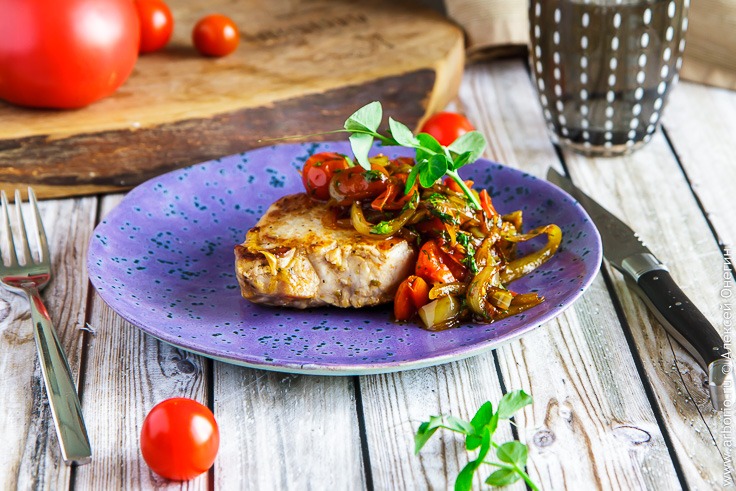
Let the meat rest
Take the meat out of the oven or take the steak off the grill? I bet all you want at this moment is to quickly cut yourself a piece and enjoy the taste of the delicious meat that exudes this maddening aroma. But don’t rush: without allowing the meat to “rest”, you risk losing most of the juices it contains: once you make a cut, they will simply flow out onto the plate.
Why is this happening? There are several different theories, but they all boil down to the fact that due to the difference in temperature inside and on the surface of the meat, an imbalance is created in the distribution of juices inside the piece. As the surface cools and the interior warms from residual heat, the juices will be evenly distributed inside. The lower the degree of frying of the meat and the larger the size of the piece, the longer it needs to rest: if five minutes for a steak in a warm place under a layer of foil is enough, a large roast beef of several kilos may need all of half an hour.
Cut against the grain
Sometimes it happens like this: the meat seems incredibly tough, but the problem is not that it is really tough, but that you are eating it incorrectly. The structure of meat can be imagined as a tightly assembled bundle of fairly thick threads - muscle tissue fibers. Separating fibers from one another is much easier than cutting or even biting one of them. For this reason, any meat should be cut across the grain: this will make it easier for you to chew it.
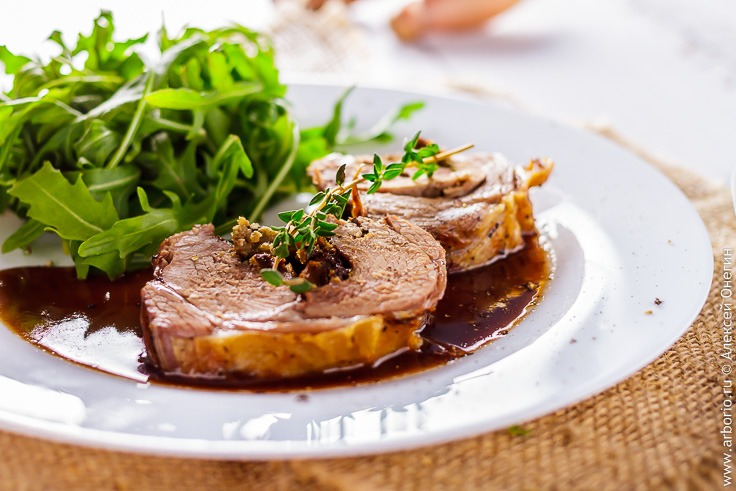
Repel
So, where acid and salt failed, mechanical action will help! By beating the meat with a special hammer or just your fist, or using a special tenderizer, you destroy its structure, doing in advance the work that your teeth would have to do. This method can be used both to prepare all kinds of schnitzels and chops, and to give a large layer of meat the same thickness - for example, to then roll it into a roll.
However, the general rule is: if you can't hit, don't hit. By destroying the structure of meat, you are depriving yourself of those textural nuances that usually make up a large part of the pleasure of eating meat dishes, so you should not try to soften already soft meat.
Master
The most advanced and trouble-free way to cook meat soft and juicy, from absolutely any cut, is the sous vide technology. For those who do not yet know what this is, I will explain: products (in our case, meat) are packaged in a vacuum bag and cooked for a long time in water heated to a certain temperature - for example, . As a result, the meat is incredibly juicy and soft. The word “incredible” is not a figure of speech here: if you haven’t tried sous vide meat, don’t even try to imagine its taste and texture.
To start experimenting with sous vide, you will need a vacuum sealer and special equipment, but to get started, you can get by with a slow cooker and plastic ziplock bags, which are sold in every supermarket.
Well, this guide on how to make meat tender and juicy turned out to be long and detailed, but I must have missed something. Write your favorite methods and secrets for tenderizing meat in the comments!

